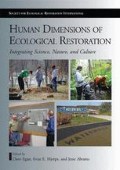Abstract
High Park is one of the largest green spaces within the city of Toronto, and it attracts people from all over the city with its beautiful lawns, attractive gardens, and oak savanna and pond restoration. Walking through the park on a sunny, summer day you encounter the diversity that is the city of Toronto—a city where about 50 percent of the residents are people who immigrated to Canada within the last ten years (Toronto Community Foundation 2004). In 2007, a park planning exercise was led by the park management and the volunteer park council to decide the direction of future park development, and specifically what role ecological restoration would play. Seventy people met on a Saturday morning to discuss the future of the park and gather input from various interest groups, including dog walkers, gardeners, cyclists, and restorationists. All seventy participants were white and seemingly of western European ancestry. They certainly did not reflect the diversity of the park’s users. Looking around the room, I questioned why diverse cultures were not engaged in this process even though they had direct interest in what happened in the park.
References
Alas, B. 2005. “Practicing Social Ecology: A Guide for Members of Our Immigrant Communities.” http://www.hispaniccouncil.net/id6.html.
Burayidi, M. A. 2000. “Urban Planning as a Multicultural Canon.” In Urban Planning in a Multicultural Society, edited by M. Burayidi, 1–15.Westport, CT: Praeger.
Common Ground Community Mapping Project. 2008. http://www3.telus.net/cground/aboutus.html.
Crosby, F., and M. Stockdale. 2004. The Psychology and Management of Workplace Diversity. New York: Wiley-Blackwell.
Desfor, G., and R. Keil. 2004. Nature and the City. Tucson: University of Arizona Press.
Foster, J. 2005. “Restoration of the Don Valley Brick Works: Whose Restoration? Whose Space?” Journal of Urban Design 10 (3): 331–51.
Gobster, P. H. 2001. “Visions of Nature: Conflict and Compatibility in Urban Park Restoration.” Landscape and Urban Planning 56 (1–2): 35–51.
Gosine, A. 2003. “Myths of Diversity.” Alternatives 29 (1): 12–14.
Higgs, E. 1997. “What Is Good Ecological Restoration?” Conservation Biology 11 (2): 338–48.
Hull, R. B., and D. P. Robertson. 2000. “The Language of Nature Matters: Toward a More Public Ecology.” In Restoring Nature: Perspectives from the Humanities and Social Sciences, edited by P. H. Gobster and R. B. Hull, 97–118.Washington, DC: Island Press.
Johnson, L. 2002. Tending the Earth: A Gardener’s Manifesto. Toronto: Penguin.
Jones, R., and S. Rainey. 2006. “Examining Linkages between Race, Environmental Concern, Health, and Justice in a Highly Polluted Community of Color.” Journal of Black Studies 36 (4): 473–96.
Kilvington, M., J. Rosier, C. Wilkinson, and C. Freeman. 1998. “Urban Restoration: Social Opportunities and Constraints.” Paper presented to the Symposium on Restoring the Health andWealth of Ecosystems, September 28–30, 1998, New Zealand.
Light, A. 2003. “Urban Ecological Citizenship.” Journal of Social Philosophy 34 (1): 44–63.
Lopez, T., and B. Thomas. 2006. Dancing on Live Embers: Challenging Racism in Organizations. Toronto: Between the Lines.
Martin, D. C. 2004. “Apartheid in the Great Outdoors: American Advertising and the Reproduction of a Racialized Outdoor Leisure Identity.” Journal of Leisure Research 36 (40): 513–35.
McDonough, M., L. Burban, and K. Russell. 2003. “Dialogue on Diversity: Broadening the Voices in Urban and Community Forestry.” http://www.na.fs.fed.us/spfo/pubs/uf/diversity_rpt/diversity_rpt.htm.
Milroy, B., and M.Wallace. 2002. “EthnoracialDiversity and Planning Practices in the Greater Toronto Area.” http://ceris.metropolis.net/Virtual%20Library/housing_neighborhoods/WK18_Milroy_Wallace.pdf.
Neumann, R. 2002. Imposing Wilderness: Struggles over Livelihood and Nature Preservation in Africa. Berkeley: University of California Press.
Newman, A. 2008. “Inclusive Planning of Urban Nature.” Ecological Restoration 26 (3): 229–34.
Papillon, M. 2003. “Immigration, Diversity, and Social Inclusion in Canada’s Cities.” Ottawa: Canadian Policy Research Networks. http://www.cprn.org.
Pestieau, K., and M. Wallace. 2003. “Challenges and Opportunities for Planning in the Ethnoculturally Diverse City: A Collection of Papers—Introduction.” Planning Theory and Practice 4 (3): 253–58.
Ramos, D. 2005. Social Ecology Project Newsletter: Awakening Consciousness to Revive Our Health. http://www.hispaniccouncil.net.
Sandercock, L. 1998. Towards Cosmopolis. New York: Wiley & Sons.
Siemiatycki, M., and E. Isin. 1997. “Immigration, Diversity, and Urban Citizenship in Toronto.” Canadian Journal of Regional Science 20: 73–102.
Statistics Canada. 2003. “Ethnocultural Portrait—2001 Census.” http://www12.statcan.ca/english/census01/products/analytic/companion/etoimm/contents.cfm.
Statistics Canada. 2007. “Caring Canadians, Involved Canadians: Highlights from the 2007 Canada Survey on Giving, Volunteering and Participating.” http://www.givingandvolunteering.ca/.
Sustainable South Bronx. 2007. “B.E.S.T. Project.” http://www.ssbx.org/best.html.
Toronto Community Foundation. 2004. “Toronto’s Vital Signs 2004.” http://www.tcf.ca/vital_signs/index.html.
Westphal, L.M. 2003. “Social Aspects of Urban Forestry: Urban Greening and Social Benefits: A Study of Empowerment Outcomes.” Journal of Arboriculture 29 (3): 137–47.
Author information
Authors and Affiliations
Corresponding author
Editor information
Rights and permissions
Copyright information
© 2011 Island Press
About this chapter
Cite this chapter
Newman, A. (2011). Inclusive Urban Ecological Restoration in Toronto, Canada. In: Egan, D., Hjerpe, E.E., Abrams, J. (eds) Human Dimensions of Ecological Restoration. Society for Ecological Restoration. Island Press, Washington, DC. https://doi.org/10.5822/978-1-61091-039-2_5
Download citation
DOI: https://doi.org/10.5822/978-1-61091-039-2_5
Publisher Name: Island Press, Washington, DC
Online ISBN: 978-1-61091-039-2
eBook Packages: Earth and Environmental ScienceEarth and Environmental Science (R0)


